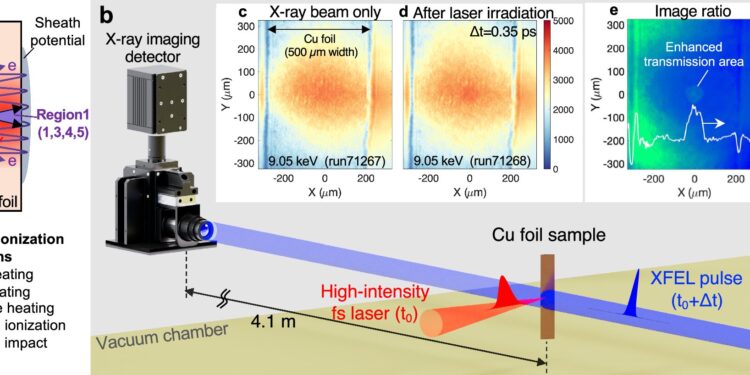Fast electronic isochoric heating mechanisms in a solid sheet and experimental setup. Credit: Nature Communications (2024). DOI: 10.1038/s41467-024-51084-4
In a matter of picoseconds (trillionths of a second), a small piece of copper momentarily transforms into dense plasma, a state called hot dense matter, hot being a relative term: the metal reaches nearly 200,000 degrees Fahrenheit. Thanks to the short duration of a high-power laser pulse, the copper goes from a solid state to a plasma state in an instant before exploding. Understanding the heat progression in copper is an exciting advance in the physics of giant planet interiors and laser fusion fuel cores.
Hiroshi Sawada, an associate professor in the department of physics at the University of Nevada, Reno, and colleagues at several international institutions have developed a method to track how material heats and cools after a laser pulse is fired.
In a research article published this week in Nature CommunicationsThe researchers explain their method.
Using ultrashort duration X-ray pulses from the X-ray free-electron laser (XFEL) at the SPring-8 Angstrom Compact Free-Electron Laser Facility (SACLA) in Japan, physicists can “see” the temperature of the material change over time, providing insight into how plasma forms when metal is zapped by high-power lasers.
Because of the extremely rapid heating phenomenon, it was previously difficult or impossible to collect data on how the plasma state progresses through copper or other materials. In a so-called pump-probe experiment, physicists used a relativistic-intensity laser pulse from a high-power laser to first heat a small piece of copper (pump), and then an X-ray pulse from a secondary laser collected X-ray images of the copper (probe).
Then, temperatures and degrees of ionization, or the presence of plasma in the copper, were inferred from the image data. The researchers repeated this experiment several times, delaying the secondary laser pulse a little longer with each shot to track the progression of heat through the material.
The XFEL and high-power lasers used in these experiments are located at one of only three facilities in the world capable of performing these pump-probe experiments, the others being the Linac Coherent Light Source (LCLS) at SLAC National Accelerator Laboratory in the United States and the European XFEL in Germany. The researchers initially conducted these experiments before the COVID-19 pandemic using SACLA built by RIKEN and the Japan Synchrotron Radiation Research Institute (JASRI). XFELs are essential tools in a wide range of fields, including chemical engineering and biochemistry.
The results of laser shooting are the most accurate data on how the material changes when heat is transferred at the micron scale. As an example, a human hair is about 70 microns thick.
A researcher holds the scaffolding on which tiny sheets of copper are attached. These copper pieces will be struck with a laser, which heats them to thousands of degrees Fahrenheit. Credit: Hiroshi Sawada
“We had made some predictions from simulations, but they were totally different from what we saw,” Sawada said. “We were overwhelmed by the number of surprising results from our first experiment, and we didn’t know which one to highlight.”
The researchers expected the copper to be transformed into a conventional plasma after being hit by the laser pulse. Based on the X-ray pulse, the researchers discovered that the plasma was actually a state of dense, hot matter.
Samples with reliable results are important for laser experiments because X-ray laser beam time is extremely competitive. It can take years before a research group has access to a specific laser. In this study, copper samples were laser cut into strips and manually mounted on a sample holder. Each laser shot destroyed the copper strip, and the team was able to collect data from 200 to 300 targeted shots.
The improved technology using XFEL pulses achieves finer temporal and spatial resolution than conventional methods. While a tenth of a billionth of a second seems imperceptibly small, a lot can happen at the atomic level, including heat fronts traveling at close to the speed of light. Diagnosing dense, hot matter remains a challenge, requiring more precise technology and cross-checking methods, Sawada said.
Sawada’s co-authors include physicists from JASRI, RIKEN, Osaka University’s Institute for Laser Engineering, SLAC National Accelerator Laboratory operated by Stanford University, the University of Alberta, Lawrence Livermore National Laboratory, and the Laboratory for Laser Energetics at the University of Rochester.
Sawada envisions using this method in several areas of physics, including plasma physics, high-energy density science, astrophysics, inertial fusion energy research, and quantum and atomic physics. It may be applied in other free-electron laser facilities, such as SLAC’s next-generation MEC-U facility, which combines high-power petawatt lasers and high-energy kilojoule lasers with LCLS.
Additionally, these results shed light on how quickly and efficiently heat is transferred from lasers to high-density material, a topic that deserves further exploration using very high-intensity lasers such as the NSF ZEUS Laser Facility at the University of Michigan and a future NSF OPAL laser at the University of Rochester.
It can also be used to study how micron-scale deformations in the fired material can affect how heat is transferred through the material, and using lasers based at other facilities with different energy efficiencies, to test the progression of heat in different materials.
More information:
H. Sawada et al, Spatiotemporal dynamics of rapid electron heating in solid-state matter via XFEL, Nature Communications (2024). DOI: 10.1038/s41467-024-51084-4
Provided by the University of Nevada, Reno
Quote:Tracking plasma progress in a picosecond: Physicists develop ultrafast laser method to study high-density plasmas (2024, September 18) retrieved September 18, 2024 from
This document is subject to copyright. Apart from any fair dealing for the purpose of private study or research, no part may be reproduced without written permission. The content is provided for informational purposes only.



